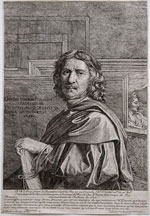Self portrait by Poussin
Jean Pesne (Rouen, 1623-Paris, 1700), d’après Nicolas Poussin
Autoportrait de Nicolas Poussin
Sans date (vers 1660)
Etat définitif
Eau-forte rehaussée au burin
Collection particulière

Autoportrait de Poussin
gravé par Jean Pesne
© Collection particulière
In this space you can see portraits of the figures who contributed to the creation of the Moses tapestry: the painters Nicolas Poussin and Charles Le Brun, as well as the Minister François-Michel Le Tellier, Marquis de Louvois.
On your left is an engraving, after a famous self portrait by Nicolas Poussin.
This French painter, who was born in 1594 near Rouen and died in 1665 in Rome, was one of the greatest classical painters of the 17th century.
From his youth, Poussin found his models among Italian painters. So at the age of 30 he set off for Italy and spent most of the rest of his life there. Impressed by the harmony of the Italian countryside, he found his inspiration when out walking. Poussin only returned to France from 1640 to 1642 at the invitation of King Louis XIII and Cardinal Richelieu.
It was not until his death in 1665 that several of his paintings on the theme of Moses were transposed into large tapestries. Indeed, in his lifetime, the artist always refused this type of commission, preferring work produced on the easel.
In addition to the eight tapestries woven after the master’s paintings, you can also see in this exhibition four preparatory drawings and three paintings by the artist, on exceptional loan from the Louvre!
